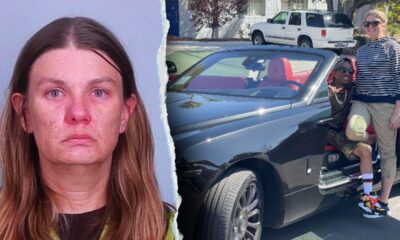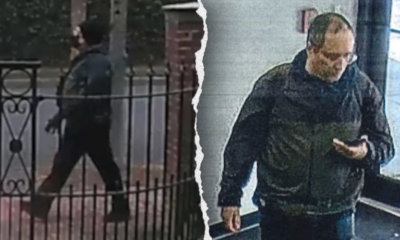Lifestyle
Are you oblivious to L.A. earthquakes? Here's why you might be a 'never-feeler'

Joy Lee has lived in the L.A. area for her entire life, but the 48-year-old says she hasn’t felt an earthquake in almost two decades. “Sometimes I will be on social media and suddenly my friends will start commenting on the earthquake, and I will realize I felt nothing,” she said.
One time she thought an earthquake may have happened after seeing a strange ripple in the tank of her 5-gallon water dispenser. It was “like the scene where the glass of water vibrates in ‘Jurassic Park.’”
As usual, she went to social media to confirm her suspicions. Indeed, there’d been a quake that, once again, she didn’t feel.
Lee is what we’ve dubbed a “never-feeler,” someone who never — or very, very rarely — registers the rumblings of the earth beneath their feet.
After two early January SoCal quakes (a 4.1 magnitude on New Year’s Day and a 4.2 four days later), The Times conducted an informal survey to find out more about the chronically earthquake-oblivious. Lee was among the readers to share their feelings — or lack thereof.
On Tuesday, a 2.8 magnitude quake was reported in View Park-Windsor Hills at 8:19 a.m. While this one would be considered a “light” earthquake — too low to trigger the shake alert app — more than 170 people shared did-you-feel-it reports within 30 minutes, according to the U.S. Geological Survey.
Of 116 Times questionnaire respondents, about a quarter described themselves as avowed never-feelers; people who, despite living in the L.A. area for between two and 42 years, had never felt even the slightest quiver no matter the magnitude. Meanwhile, 61% reported that, while they had indeed felt the earth tremble at some point — especially if the quake was on the bigger side — they haven’t felt one in a very long time.
Julian Lozos, an associate professor of geophysics at Cal State Northridge, said there is solid earthquake science behind why some folks feel quakes while others don’t in any given situation.
“In general, you’re more likely to feel earthquakes if you’re sitting still [instead of] moving around, you’re more likely to feel them if you’re awake [instead of] asleep — obviously — but it also depends on where you are. There have been earthquakes in the San Fernando Valley, for example, that I’ve felt while people just on the other side of the Santa Monica [Mountains] haven’t.
“And it would definitely depend on where you live in terms of there being a constant source of noise or movement, like living in an apartment building where there’s constantly other stuff going on versus a single-family home. In that case you’re more likely to either think that’s what it is or, more likely, to just have developed the ability to tune it out.”
Indeed, Lee thinks her location may play a role in her earthquake ignorance. “[I] only have been quake-oblivious since moving into our home in Mt. Washington 17 years ago,” she said. “I think it has to do with the geology that our house sits on.” Linnea Stanley, a four-year Angeleno who lives in Bel-Air but used to live in Beachwood Canyon by the Hollywood sign, wondered if she never feels earthquakes because “maybe I live far enough [away] from them?” Isabel Corazon, a 37-year-resident born and raised in L.A. and currently residing in downtown’s Historic Core, believes she may have grown immune.
“I do find it strange since I’m hypersensitive to how others are feeling at any given moment in addition to how I’m feeling at any given moment,” Corazon said. “I’m highly intuitive and perceptive. So I’m honestly confused as to why I never feel earthquakes. … Maybe when you have generational time spent in L.A., you become like one with the earthquake?”
Lozos, whose area of expertise is computer simulations (“I make fake earthquakes on my computer”) has a keen interest in the never-feeler phenomenon, having observed it firsthand in the classroom.
“I always ask my students if they’ve felt an earthquake, and most of them say they have — but some of them say they haven’t,” Lozos said. “And I think some of that has to do with how much are they even thinking about it? I’m thinking about earthquakes most of the time, because it’s my job, right? So I’m more likely to feel something and go, ‘OK, was that an earthquake? Or was that my neighbors, or was that the fire station across the street?’ Whereas people who aren’t necessarily thinking about it all the time … chances are they probably have felt earthquakes and just never thought to look into it. It’s like how much does it come to your mind to begin with?”
The never-feelers’ theories
Generally, the survey respondents who don’t feel earthquakes had three main reasons. A third of them, including Lee, cited their physical location.
Lozos explained that differing locations — even within the same building — can make a huge difference in how a quake is felt. He used his personal experience at a 2014 earthquake conference in Japan as an example. “It was lunchtime and they had half of us at a fourth-floor restaurant and half of us at an 18th-floor restaurant in the same hotel when a magnitude 4.9 earthquake hit,” he said. “The people on the fourth floor felt a very sort of abrupt shaking — a jolty shaking — and the people on the 18th floor felt a lot more swaying. … [which] one might perceive as the wind versus an earthquake.”
Others theorized they had become desensitized to the jolts, jiggles and sways of the earth, due to medical conditions (from ADHD-induced wiggling legs to frequent seizures), previous earthquakes or even where they grew up. “As a native Seattleite, I have spent A LOT of my life on boats (rowboats, ferry boats, speed boats, crew shells, kayaks, canoes, etc.),” wrote Colleen Davis. “Therefore, I am very used to the feeling of having sea legs and having water rolling under me. Who knows if there is a connection? But it makes as much sense as any other theory, I guess.”
Lozos said most earthquakes are small and last for a very short period of time — a second or less. “And there are so many other things that can cause movement like that, that it might not even be something you think to check. So, later on, when the earthquake is on the news, or is exploding on [X] or BlueSky or Mastodon or wherever you are, you have to step back and think, ‘Did I feel something earlier? What time was that?’ There’s probably a lot of that.”
A surprising number of respondents (to me at least) simply copped to being too distracted to notice. “I honestly feel like I just don’t pay attention,” explained Tess Steplyk of her six-year streak of quake obliviousness. “But most the time I am quietly working from home. So I think it’s a skill!”
Not paying attention is what Lozos thinks is probably at work for people who haven’t experienced a single shaker. “I’d be willing to bet that if they’re adults who have lived in California their whole lives,” he said, “they probably have [felt an earthquake] and just didn’t realize what it was. Also, if you haven’t felt one before, you probably have this mental image, like it’s going to be this big obvious thing. And, most of the time, they’re not.”
Didn’t feel it? Don’t be surprised.
Since 1999, the USGS has been running a postquake questionnaire called “Did You Feel It?” It asks people to detail the intensity of shaking and report damage. According to Vince Quitoriano, the program’s developer, of the more than 450,000 Los Angeles County responses since launch, about 96% reported having felt a quake. Using its questionnaire data, the USGS has found that fewer than 10% of people are likely to feel a quake with moderate shaking if they are outside and in motion (say, walking or driving) while roughly 85% of people at rest and located on the higher floor of a building will feel the same intensity quake.
However, the survey wasn’t designed to gather granular data from those who didn’t feel anything, says survey geophysicist David Wald, the scientist behind and manager of the Did You Feel It? system (who created it in the aftermath of the 1994 Northridge quake). “What’s really unfortunate is that to answer the questionnaire to say you didn’t feel it just takes one answer,” Wald said. “And then you’re done. … We get their location, we get the actual intensity [of the quake] where they are based on other people’s reports and we typically know what story [of a building] they were in. But we haven’t put a lot of effort into [exploring] the boundaries of the have-not-felt because that’s such a small fraction.”
Even so, Wald isn’t surprised that some people who have lived in the L.A. area for decades would say they have never felt a single earthquake.
“On the scientific level, I would say that there are definitely so many circumstances that it would absolutely make sense that they didn’t,” he said. “It could have been that [during] one they should have felt they were in a car or in a small building and far enough away where only half the people would have felt it and they were watching TV loudly or whatever. … So even if you lived in L.A., in the early ’90s, you might be in the situation where you wouldn’t have felt an earthquake.”
Hacks for the never-feeler
Given how much where you are, what you’re doing and what you’ve previously experienced can affect your ability to feel any given earthquake, what’s an on-edge Angeleno to do? And can the never-feelers somehow train themselves to become more quake-conscious? When I put that question to Lozos, his (half-joking) response was: “I think the easy answer is to become an earthquake scientist!”
Since that’s not exactly a workable option for most (and even if it were, it certainly couldn’t happen overnight), here are some of the life hacks sent along in the responses to The Times survey. While I can’t personally vouch for them (well, except for the chandelier one — a delicate oyster-shell chandelier in the bedroom serves as the earthquake early-warning system in my home) and nothing should take the place of actual earthquake preparedness, below are some of the clever cues folks rely on to clue them in when they aren’t personally noticing the earth move.
- “We have a chandelier that sways when we have an earthquake. I’ll look up at that if I think we are having one.” — Maribel Diaz
- “I have wind chimes.” — Bonnie Howard
- “[I rely on an] under-the-cabinet wine glass rack. And the best life hack of all — my three cats! All three will perk up, usually meerkat-style, and all look the same direction.” — Lyndsi Gutierrez
- “I use a bobblehead from a sports team, because why not?!” — Lakshmivallabh Pandalapalli
- “I have hanging plants in many rooms of my house, and if the plants are moving that’s my sign that something went down.” — Amanda Rodriguez
- “Mini-blinds and the pool water are clues for the larger ones further away. Twitter and Facebook are helpful for the smaller ones nearby.” — Angel Zobel-Rodriguez
- “In San Francisco, I had a dresser in our bedroom with handles that lay against the drawer face. If I heard them start to rattle, I knew there was an earthquake happening.” — R.W. Ziegler
- “[My] USGS auto alerts [are] set to a low threshold, like a 3.0 on the scale, in a large radius around L.A. They’re sent instantly! Never fails.” — Jackson Finnerman
- “Dogs. My dogs know when one is coming. So they let me know.” — Eileen O’Farrell

Lifestyle
Best Christmas gift I ever received : Pop Culture Happy Hour

Lifestyle
L.A.’s latest viral party spot is … Seafood City. Yes, you read that right

Under the glow of fluorescent lights at Seafood City market in North Hills, packages of pre-made adobo, salted shrimp fry and and dried anchovies glisten in meat coolers.
A DJ, dressed in a traditional barong, blasts a dance remix of Whitney Houston’s “I Wanna Dance with Somebody” as a crowd gathers to take a shot of fish sauce together.
“That was disgusting!” a man shouts into the mic, flashing a grimacing expression.

At Seafood City, DJs 1OAK, left, EVER ED-E and AYMO spin in barongs, the Philippines’ national formal shirt.
The smells of lechon and lumpia float through the air. Smiling children munch on halo-halo (a Philippine dessert made with ube ice cream, leche flan and shaved ice). Flags of the Philippines wave in the air as a man in UCLA Health scrubs hops into the center of an energetic dance circle. Employees shoot store coupons out of a money gun and toss bags of Leslie’s Clover Chips into the crowd. Fathers hold their children on their shoulders as a group of college students perform a Tinikling routine, a traditional Philippine dance in which performers step and hop over and between bamboo poles.
“This is so Filipino,” a woman says, in awe of the scene.

Sabria Joaquin, 26, of Los Angeles, left, and Kayla Covington, 19, of Rancho Cucamonga hit the dance floor at “Late Night Madness” in North Hills.
“I came here for groceries,” explains an elderly man, adding that he decided to stay for the party.
Seafood City, the largest Philippine grocery store chain in North America, typically closes at 9 p.m. But on certain Friday and Saturday nights, its produce or seafood aisle turns into a lively dance floor for “Late Night Madness.” On social media, where the gathering has exploded, it looks like a multigenerational nightclub that could use dimmer lighting. But for attendees who frequent the store, it’s more than that. It’s a space for them to celebrate their Filipino heritage through food, music and dance in a familiar setting.
“This is something that you would never expect to happen — it’s a grocery store,” says Renson Blanco, one of five DJs spinning that night. He grew up going to the store with his family. “My mom would [put] us all in the minivan and come here, and she’d let us run free,” he adds. “It’s comfortable here. It’s safe here.”
1. Rhianne Alimboyoguen, 23, of Los Angeles follows an employee through the produce section. 2. Allison Dove, 29, left, and Andrea Edoria, 33, both of Pasadena, enjoy Philippine street food. 3. Katie Nacino, 20, left, Daniel Adrayan, 21, and Sean Espiritu, 21, of the Filipino American Student Assn. at Cal State Northridge, practice tinikling, a traditional Philippine folk dance, in an aisle.
The first Seafood City location opened in 1989 in National City, a suburb of San Diego, which has a nearly 20% Asian population including a rich Filipino community. For its founders, the Go family, the mission was simple: to provide a market where Filipinos and people within the diaspora could comfortably speak their native language and buy familiar products. It’s since become a community anchor. Of the nearly 40 locations in Northern America, at least half of them are based in California, which has the highest population of Asian Americans in the United States.
-
Share via
The first “Late Night Madness” event happened in September in Daly City, Seafood City’s newest location. The company wanted to launch a street food program at the store’s food hall in a fun and creative way.
The DJ played a selection of hip-hop, pop, soul and classic Pinoy records like VST & Company’s “Awitin Mo, Isasayaw Ko.” Hundreds of people showed up, and videos of people of all ages turning up in the popular supermarket spread like wildfire. So the company decided to continue hosting the event in October during Filipino American History Month and for the rest of the year. It’s since expanded to more locations around the country and in L.A., including Eagle Rock.
By 10 p.m. at the Seafood City in North Hills, at least 500 people are dancing in the produce section, next to rows of saba bananas, fresh taro leaves and bok choy. The lively crowd forms dance circles throughout the night, taking turns jumping in the center to show off their moves to songs like Earth, Wind & Fire’s “Let’s Groove,” “Nokia” by Drake and Justin Bieber’s “I Just Need Somebody to Love.” At one point, TikToker and artist Adamn Killa hops on the mic and says “If you a Filipino baddie, this is for you,” before doing his viral dance.

Among the Philippine street food offerings were pandesal sliders, lumpia-style nachos, lobster balls and various skewers.
A group of employees dance behind the counter as they serve hungry patrons who fill their trays with various Filipino street food including pandesal sliders (soft Philippine bread filled with adobo, lechon or longganisa) and Lumpia Overload (think nachos, but a bed of lumpia instead of tortilla chips), lobster balls and barbecue chicken skewers. (No alcohol is served.) Meanwhile, a few lone shoppers sprinkle into the store to get their weekly groceries as music blasts through the speakers.
First-generation Filipino American Andrea Edoria of Pasadena says “Late Night Madness” reminded her of the family parties she attended as a child in L.A. and in Manila, where her parents are from.
“Growing up as a child of immigrants, I was kind of self conscious about displaying too much of my culture,” she says between bites of spiral fried potato. She went to the Eagle Rock event with her mother last month as well. “So it kind of fed my inner child to see so many people celebrating this shared culture and experience that we each grew up [with].”

A multi-generational crowd is drawn to the dance floor. At center is Jade Cavan, 44, of Chatsworth.

Members of the Filipino American Student Assn. at Cal State Northridge perform a tinikling performance.
She adds, “I think it’s so important especially now at a time where our country is so divisive and culture is kind of being weaponized, I think it’s a beautiful reminder that we can come together and find something that unites us.”
About 10 minutes before midnight, the grocery store is still bustling with activity. A dance battle breaks out and people begin hyping up the young women. The DJ transitions into slower tracks like Beyoncé’s “Love on Top” and Mariah Carey’s “All I Want for Christmas is You.” The remaining folks sing along loudly as they walk toward the exit, smiles imprinted on their faces. Staff rush to clean up, then huddle together for group photos to memorialize the evening.

After the final song is played, employees rush to clean up the supermarket.
Patrick Bernardo, 34, of Van Nuys looks at the counter, where a man had been chopping lechon, before stepping outside.
“There’s barely anything left on that pig,” he says, pointing to it as proof that the night was a success.
Lifestyle
10 books to help you understand America as its 250th birthday approaches

With the nation’s big 2-5-0 coming up next year, NPR staff and critics recommended a lot of U.S.-focused titles for Books We Love, our annual year-end reading guide. Below you’ll find 10 favorites — perfect for the history buff on your gift list, or anyone looking to learn more about how the U.S got to where it is today. Read on, or check out our full 2025 list here.

American Grammar: Race, Education, and the Building of a Nation, by Jarvis R. Givens
In this deeply researched book, Harvard University professor of education and African American studies Jarvis R. Givens locates 1819 as a “crossroads” in the history of education in the United States. That year, Congress passed the Civilization Fund Act, providing funding for assimilative boarding schools for Native American children, and the governor of Virginia signed an anti-literacy law that made it a crime to teach enslaved people to read and write in schools. Amid the Trump administration’s effort to dismantle the Department of Education, Givens’ clear-eyed assessment of American education offers an opportunity to reflect on the long-standing relationships among race, power and schooling in the U.S. — Kristen Martin, book critic and author of The Sun Won’t Come Out Tomorrow: The Dark History of American Orphanhood

The Fate of the Day: The War for America, Fort Ticonderoga to Charleston, 1777-1780, by Rick Atkinson
I’ve been eagerly waiting years for this book! This is the second volume of Rick Atkinson’s trilogy on the American Revolution. Atkinson makes good use of letters and diaries. You feel like you’re in the middle of a battle, with all the sights, sounds and tragedy. Harrowing tales of hand-to-hand fighting, scalping and desperate evacuations. Fine detail: the waxed mustaches of the Hessian forces, the number of rum barrels distributed to weary and ill-clad troops, the dull thud of cannonballs smacking into ships. The stench of makeshift hospitals, with piles of limbs stacked outside. He carefully lays out how the battles began, and the successes, mistakes and missed opportunities – on both sides. — Tom Bowman, Pentagon reporter

History Matters, by David McCullough, Dorie McCullough Lawson (contributor), and Michael Hill (contributor)
If history can be a comfort read, this is it. David McCullough’s daughter Dorie McCullough Lawson and his longtime researcher, Michael Hill, assembled this posthumous collection over two years. Some of the historian’s old manuscripts and files were kept in a New England barn, so the occasional acorn and nest turned up along with the historian’s glorious observations about Americans and their history. The essay subjects are diverse – painter Thomas Eakins, Harriet Beecher Stowe in Paris, “A Book on Every Bed” (it will melt your heart). One theme emerges that you might find reassuring in its own way: There was no “simpler time.” — Shannon Rhoades, supervising senior editor, Weekend Edition

Last Seen: The Enduring Search by Formerly Enslaved People to Find Their Lost Families, by Judith Giesberg
In 2017, historian Judith Giesberg and her team of graduate student researchers launched a website called the “Last Seen” project. It now contains over 5,000 ads placed in newspapers by formerly enslaved people hoping to find family members separated by slavery. The ads span the 1830s to the 1920s and serve as portals “into the lived experience of slavery.” In Last Seen, her book drawn from that monumental website, Giesberg closely reads 10 of those ads placed in search of lost children, mothers, wives, siblings and comrades who served in the United States Colored Troops during the Civil War. — Maureen Corrigan, book critic, Fresh Air

Medicine River: A Story of Survival and the Legacy of Indian Boarding Schools, by Mary Annette Pember
Mary Annette Pember, a citizen of the Red Cliff Band of Wisconsin Ojibwe and a national correspondent at ICT News, grew up in the 1950s and 1960s as her mother’s “secret confessor,” listening to fairy-tale-like stories of the horrors she endured at an assimilative boarding school. In Medicine River, Pember traces the repercussions of her mother’s maltreatment, situating her family’s story within the United States’ systemic use of education to eradicate Native cultures. Through an approach that is “part journalistic research, part spiritual pilgrimage,” Pember provides a cuttingly personal account of the history of federally funded Indian boarding schools and a moving look at how Indigenous traditions and rituals can light the path for healing. — Kristen Martin, book critic and author of The Sun Won’t Come Out Tomorrow: The Dark History of American Orphanhood

Mother Emanuel: Two Centuries of Race, Resistance, and Forgiveness in One Charleston Church, by Kevin Sack
There was great symbolism when a white supremacist targeted Charleston’s Mother Emanuel African Methodist Episcopal Church, killing nine Black worshippers as a means to ignite a race war. As we learn in this deeply researched history, the congregation has been involved in the struggle for racial justice ever since it was founded in an “act of bold subversion” by enslaved and free African Americans in the 1800s. I am struck by the stories of clergy and members who fought against seemingly insurmountable odds at nearly every turn of history, truly living out their faith and believing in a better America. — Debbie Elliott, correspondent, National Desk

There Is No Place for Us: Working and Homeless in America, by Brian Goldstone
In this paradigm-shifting, immersive book, journalist and anthropologist Brian Goldstone follows five families in Atlanta who, despite working full time, struggle to stay housed amid gentrification, a lack of tenants’ rights and low wages. These families, all Black, fall into a “shadow realm” – they are not considered officially homeless by the federal government, but lack a fixed living place as they double up with friends and family, sleep in their cars, or pay exorbitant rates at extended-stay hotels. Woven throughout their stories is a trenchant exploration of how America’s disinvestment in public housing and relentless pursuit of free-market growth have fueled housing insecurity for poor working families. — Kristen Martin, book critic and author of The Sun Won’t Come Out Tomorrow: The Dark History of American Orphanhood

The War of Art: A History of Artists’ Protest In America, by Lauren O’Neill-Butler
This book is about the creative – if often short-lived and not always successful – ways in which artists have fought for social change in the U.S. since the 1960s. Personal favorite: a chapter on how the scrappy video collective, Top Value Television (TVTV), changed the public’s view of political conventions. With artist-led protests once again becoming a thing – from the thousands of actors and filmmakers who recently pledged to boycott the Israeli movie industry in response to the humanitarian crisis in Gaza, to the presence of a 12-foot statue depicting President Trump and the late sex offender Jeffrey Epstein frolicking on the National Mall, this book about the past provides a powerful frame for thinking about artist-led actions today. — Chloe Veltman, correspondent, Culture Desk

We the People: A History of the U.S. Constitution, by Jill Lepore
As the U.S. approaches the 250th anniversary of its founding, it feels like an appropriate time to reflect on where we’re at as a country and how we got here. We the People, by Jill Lepore, a history and law professor at Harvard University, helps satisfy that impulse. It tells the story of the U.S. Constitution, which is among the world’s oldest constitutions. Lepore focuses on battles over amendments, which were fought not just by politicians but by ordinary Americans. The founders designed the Constitution to be amended, but it has become much more difficult to do so over the years. As the Constitution becomes harder to amend, Lepore writes, the risk of political violence becomes greater. — Milton Guevara, producer, Morning Edition and Up First

Who Is Government?: The Untold Story of Public Service, by Michael Lewis (editor)
Thousands of unsung heroes in the government are making life better for Americans. But because of bureaucracies being made up of bureaucrats, we rarely hear those stories. This book showcases them. Like a coal-mining safety official who helped the U.S. reach zero mine-collapse deaths. Or the man who has led the National Cemetery Administration to the top of the American Customer Satisfaction Index. As the federal government is in its biggest shake-up in a generation, it’s worth learning about where the bright spots are. — Darian Woods, host, The Indicator from Planet Money
This is just a fraction of the 380+ titles we included in Books We Love this year. Click here to check out this year’s titles, or browse nearly 4,000 books from the last 13 years.

-

 Iowa1 week ago
Iowa1 week agoAddy Brown motivated to step up in Audi Crooks’ absence vs. UNI
-

 Maine1 week ago
Maine1 week agoElementary-aged student killed in school bus crash in southern Maine
-

 Maryland1 week ago
Maryland1 week agoFrigid temperatures to start the week in Maryland
-

 New Mexico7 days ago
New Mexico7 days agoFamily clarifies why they believe missing New Mexico man is dead
-

 South Dakota1 week ago
South Dakota1 week agoNature: Snow in South Dakota
-

 Detroit, MI1 week ago
Detroit, MI1 week ago‘Love being a pedo’: Metro Detroit doctor, attorney, therapist accused in web of child porn chats
-

 Health1 week ago
Health1 week ago‘Aggressive’ new flu variant sweeps globe as doctors warn of severe symptoms
-

 Maine7 days ago
Maine7 days agoFamily in Maine host food pantry for deer | Hand Off





















